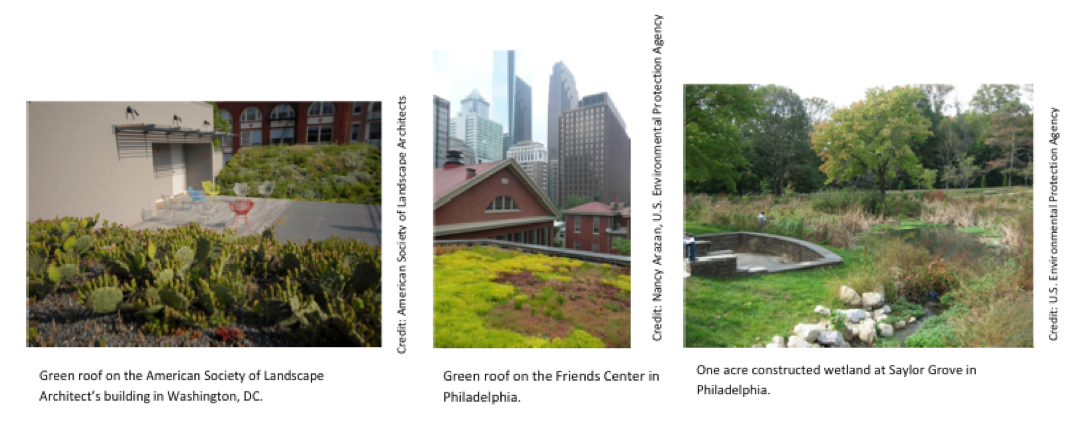AMERICAN RIVERS
Executive Summary
This white paper focuses on the potential benefits to health, safety, and equitable distribution of resources for urban communities that green infrastructure can provide. Green infrastructure practices, such as rain gardens, green roofs, and permeable pavement, are designed to capture rainwater where it falls where it can infiltrate onsite to minimize pollution impacts to nearby streams and rivers.
By providing a compendium of potential benefits that green infrastructure provides to improve community health and livability, this paper is intended as a resource for decision makers and the general public to learn more about the co-benefits of these practices. It builds upon the growing body of research into the broader benefits of green infrastructure for urban communities and focuses on how green infrastructure can prevent or reduce the public health costs associated with poor air and water quality, improve safety by reducing the potential for crime and mitigating localized flooding, and increase access to healthy and affordable food as well as access to green space for recreation. The paper also examines how green infrastructure practices can be used as part of an overall strategy for communities to mitigate and adapt to climate change impacts.
Green infrastructure practices are not a panacea for every water quality and water quantity concern. Neither should they be viewed as a silver bullet to address the many challenges urban communities face. However, with community support, these practices offer cost-effective solutions to managing polluted runoff in the face of a changing climate and harsh budget realities that also provide a wide range of benefits.
Introduction
The way we use the land, whether as farmland or cities or forests, is inherently linked to the health of local rivers, lakes, and streams. Urbanization in particular has fundamentally altered the way that water moves through the landscape. One of the defining features of urban areas is the sheer number of rooftops, roads, and parking lots – hard surfaces that are impermeable to water.
When rainwater can’t soak into the ground, it runs along streets and parking lots and picks up pollutants. Known as stormwater runoff, the Environmental Protection Agency (EPA) defines this pollutant source as rainwater or snowmelt that flows over the ground. Stormwater runoff can pick up chemicals, sediment, bacteria, and other contaminants before flowing either into a storm sewer or directly into rivers, lakes, and streams. These pollutants degrade water quality, harm aquatic life, contaminate recreational areas, and threaten drinking water supplies. According to the EPA, polluted runoff is the leading source of pollution for 40 percent of waters that fail to meet water quality standards. In the Long Island Sound alone, 47 percent of pathogen contamination is due to polluted runoff.
Many communities manage stormwater runoff by conveying the stormwater away from buildings and streets in a series of pipes and tunnels. Some communities separate stormwater and wastewater pipes in separate storm sewer systems while others, particularly older urban communities, use a combined sewer system. In a combined system, both stormwater and wastewater go to the wastewater treatment plant in the same pipe. If high volumes of rainwater or snowmelt overwhelm the capacity of the plant, untreated sewage and stormwater are released into local rivers and streams in what is known as a combined sewer overflow (CSO) event. During these events, pathogens such as Salmonella and E. coli present in sewage and other contaminants like lead and formaldehyde that are detrimental to health flow untreated into local waters. In 2001, the EPA estimated that CSOs dumped 1.3 trillion gallons of raw sewage into rivers, lakes, and streams every year.
Across the country, communities are beginning to incorporate green infrastructure practices to reduce polluted runoff, protect water quality, and ensure a reliable water supply. Green infrastructure, for the purposes of this report, is defined as an approach to wet weather management that uses natural systems, or engineered systems that mimic natural processes, to infiltrate, evapotranspire, and/or reuse stormwater runoff. In other words, these practices work to protect, restore, and replicate the natural hydrology of the landscape by capturing rainwater where it falls.
From rain gardens to green roofs, green infrastructure practices protect and restore water quality by keeping polluted stormwater out of local rivers and streams, reducing combined sewer overflows, and filtering out contaminants. Green infrastructure is also increasingly recognized for its cost effectiveness and ability to reduce energy use. Beyond even these benefits, however, green infrastructure practices offer multiple other benefits to communities that can improve health, safety, and equity. Green infrastructure practices decrease pollutant loadings into waters, which can reduce illness from recreational contact or polluted drinking water. Green infrastructure solutions can also improve air quality and mitigate the urban heat island effect to lower heat stress related illness and fatalities. By increasing the amount of green space, from parks to green roofs, these stormwater management practices can reduce potential crime by alleviating conditions that lead to aggressive and violent behavior and increasing implied and actual surveillance. Green infrastructure can also mitigate localized flooding. These practices improve access to healthy and affordable food when combined with urban agriculture strategies and to green space for recreation.
About American Rivers
www.americanrivers.org
“American Rivers is the leading organization working to protect and restore the nation’s rivers and streams. Rivers connect us to each other, nature, and future generations. Since 1973, American Rivers has fought to preserve these connections, helping protect and restore more than 150,000 miles of rivers through advocacy efforts, on-the-ground projects, and the annual release of America’s Most Endangered Rivers®.”
Tags: American Rivers, Combined Sewer Overflow, CSO, Environmental Protection Agency, EPA, Snowmelt, Stormwater Runoff







 RSS Feed
RSS Feed